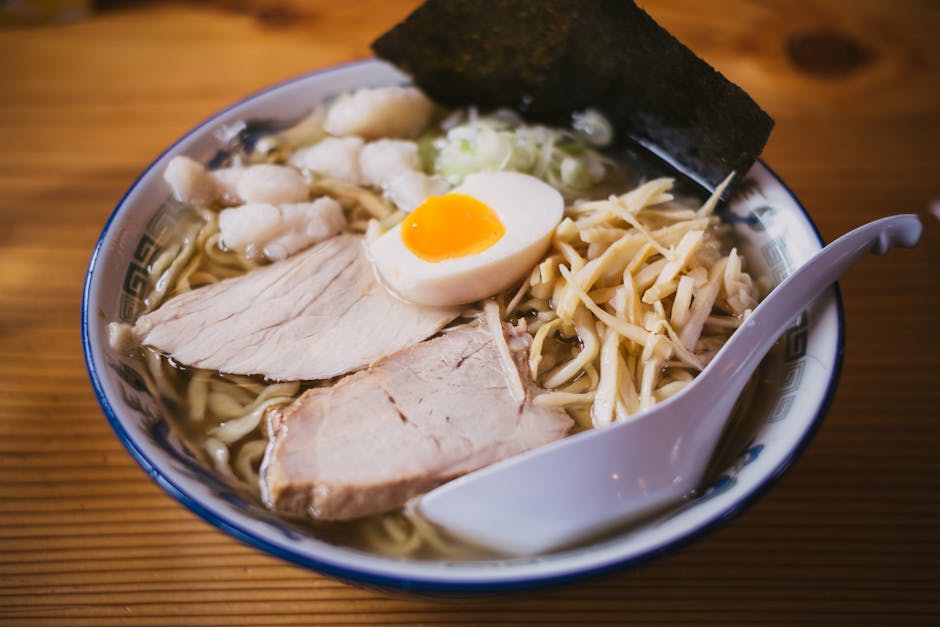Ramen Exploring Japan's Noodle Soup Obsession

Ramen Exploring Japan's Noodle Soup Obsession
Okay, let's talk ramen! Not just any ramen, but the Japanese obsession, the kind that has you planning trips around slurping the perfect bowl. I've been hooked for years, and honestly, it's more than just a meal; it's an experience, a journey, a deep dive into a world of flavor. From the bustling ramen alleys of Tokyo to the quiet local shops in Hokkaido, I've chased that perfect bowl, and let me tell you, the pursuit is half the fun. Consider this your friendly guide to understanding and appreciating Japan's iconic noodle soup.
What Exactly Is Ramen? A Delicious Definition

So, what makes ramen ramen? It's a deceptively simple question with a complex answer. At its heart, ramen is a noodle soup, but that's like calling the Mona Lisa "just a painting." Here's a breakdown:
1. Noodles: The foundation of any good ramen. These are typically made from wheat flour, water, salt, and kansui, an alkaline mineral water. Kansui gives the noodles their characteristic yellow color and chewy texture. The thickness, shape, and even waviness of the noodles can vary greatly depending on the region and the ramen style.
2. Broth: This is where the magic truly happens. Broth is the soul of the ramen, and the preparation can take hours, even days! Common types of broth include:
a. Tonkotsu: Rich, creamy, and opaque, made from boiling pork bones for an extended period. Think collagen overload! My personal favorite on a cold day.
b. Shoyu: Soy sauce-based broth, usually clear and lighter than tonkotsu. A classic and versatile choice.
c. Shio: Salt-based broth, the simplest and often clearest of the broths. It allows the other ingredients to really shine.
d. Miso: Fermented soybean paste broth, offering a deeply savory and umami-rich flavor. Comfort food defined!
3. Tare: This is the seasoning base added to the bowl before the broth. It's usually a concentrated sauce made from soy sauce, miso, salt, or other flavorings, and it's crucial for balancing the overall flavor profile.
4. Toppings: The possibilities are endless! But some common and beloved toppings include:
a. Chashu: Braised pork belly, incredibly tender and flavorful.
b. Ajitsuke Tamago: Soft-boiled marinated egg, with a perfectly runny yolk.
c. Menma: Fermented bamboo shoots, adding a slightly sweet and tangy flavor.
d. Negi: Chopped green onions, for a fresh and pungent bite.
e. Nori: Dried seaweed sheets, offering a subtle ocean flavor and a visual appeal.
f. Narutomaki: Fish cake with a distinctive swirl pattern.
g. Mayu: Black garlic oil, adding a rich and smoky depth.
Combine all these elements, and you have a bowl of ramen – a symphony of flavors and textures. But trust me, the descriptions only scratch the surface. You really have to taste it to truly understand.
My Ramen Journey: From Beginner to (Aspiring) Expert

My own ramen obsession started innocently enough. During my first trip to Japan, I stumbled into a tiny ramen shop near my hotel. The menu was entirely in Japanese, and I couldn't understand a word. I pointed randomly at a picture, and a few minutes later, a steaming bowl of tonkotsu ramen appeared before me. One sip of the broth, and I was hooked. The richness, the depth of flavor, the perfectly cooked noodles… it was unlike anything I'd ever tasted.
That was just the beginning. Over the years, I've made it a point to seek out ramen shops wherever I go. I've learned to decipher menus (sort of!), and I've discovered that each region of Japan has its own unique ramen style.
For example, in Hakata (Fukuoka), you'll find Hakata ramen, famous for its ultra-rich tonkotsu broth and thin, straight noodles. They even have a kaedama system, where you can order extra noodles to add to your remaining broth! In Sapporo (Hokkaido), Sapporo ramen reigns supreme, featuring a miso-based broth, often topped with corn and butter. It's the perfect comfort food for those cold Hokkaido winters. And in Kitakata (Fukushima), you'll find Kitakata ramen, known for its wide, flat, and wavy noodles in a pork and soy sauce broth.
My quest isn't just about eating, though. I've started to understand the craft of ramen. I've watched chefs meticulously prepare their broths, carefully selecting ingredients and patiently simmering them for hours. I've seen the dedication and passion that goes into each and every bowl. It's truly an art form.
Navigating the Ramen Scene: Tips for the Aspiring Slurper

Feeling inspired to embark on your own ramen adventure? Awesome! Here are a few tips I've picked up along the way to help you navigate the Japanese ramen scene:
1. Do Your Research: Before you go, research different ramen styles and regional specialties. Websites and food blogs (like this one!) are great resources. Knowing what to expect can help you narrow down your choices and make the most of your experience.
2. Embrace the Queue: If you see a long line outside a ramen shop, that's usually a good sign. Popular ramen shops often have queues, especially during lunchtime and dinner. Be patient, and trust that the wait will be worth it.
3. Vending Machines: Many ramen shops use vending machines to take orders. Don't be intimidated! The machines usually have pictures of the different ramen options. Select your ramen, pay with cash, and you'll receive a ticket to hand to the staff.
4. Slurp with Gusto: Slurping your ramen is not only acceptable in Japan, it's actually encouraged! Slurping helps to cool down the noodles and enhance the flavor. Don't be shy; slurp away!
5. No Talking: While not a strict rule, it's generally considered polite to focus on your ramen and avoid talking excessively while eating. Enjoy the moment and savor the flavors!
6. Explore the Condiments: Most ramen shops offer a variety of condiments, such as chili oil, sesame seeds, and garlic paste. Experiment and find your favorite combinations, but be mindful not to overpower the original flavor of the ramen.
7. Don't Be Afraid to Ask: If you have any questions or dietary restrictions, don't hesitate to ask the staff. While English may not be widely spoken, they'll usually do their best to assist you.
8. Find a Local Recommendation: A great way to find a hidden gem is to ask locals for their favorite ramen shop. They'll often point you to places you wouldn't find in guidebooks.
Beyond the Broth: The Cultural Significance of Ramen

Ramen is more than just a delicious meal; it's a cultural phenomenon in Japan. It's a symbol of affordable comfort food, a culinary art form, and a source of regional pride. Ramen shops are often small, family-run businesses, passed down through generations. They're places where people can come together to enjoy a quick, satisfying, and flavorful meal.
The popularity of ramen has also spread far beyond Japan, with ramen shops popping up all over the world. While these international versions may not always be 100% authentic, they still offer a taste of Japanese culture and a glimpse into the world of ramen. It's incredible to see how a simple bowl of noodle soup can transcend borders and connect people from different cultures.
My Top 5 Ramen Experiences (So Far!)

Okay, I couldn't resist sharing a few of my most memorable ramen experiences. These are the bowls that truly blew me away and solidified my ramen obsession:
1. Ichiran Ramen (Various Locations): A classic for a reason! The customizable ordering system allows you to create your perfect bowl of tonkotsu ramen. The private booths are a unique and fun experience.
2. Afuri (Tokyo): Known for its yuzu ramen, a refreshing and fragrant twist on the traditional dish. The broth is light and flavorful, with a distinct citrusy aroma.
3. Ramen Jiro (Tokyo): A legendary ramen shop with a cult following. The portions are massive, the broth is incredibly rich, and the atmosphere is intense. Not for the faint of heart!
4. Sumire (Sapporo): A must-try for anyone visiting Sapporo. Their miso ramen is legendary, with a rich and savory broth that will warm you from the inside out.
5. A random, unnamed shop in Kyoto: Honestly, I can't even remember the name of the place. I stumbled upon it while exploring Gion and had a shoyu ramen so perfect, so simple, it was mind-blowing. That's the magic of ramen – you can find incredible flavors in the most unexpected places.
Making Ramen at Home: A Beginner's Guide

Inspired to try making ramen at home? It can seem daunting, but it's definitely possible! While replicating the flavors of a professional ramen chef takes time and practice, you can create a delicious and satisfying bowl with a little effort. Here's a simplified version to get you started:
1. The Broth: For a quick and easy broth, use store-bought chicken or pork broth as a base. Enhance the flavor by adding ingredients like:
a. Dried shiitake mushrooms
b. Kombu (dried kelp)
c. Ginger
d. Garlic
e. Chicken or pork bones (if you have them!)
Simmer these ingredients in the broth for at least an hour to extract their flavors. Strain the broth before using.
2. The Tare: Combine soy sauce, mirin (sweet rice wine), sake, and a pinch of sugar in a saucepan. Simmer over low heat until slightly thickened. This will be your seasoning base.
3. The Noodles: Look for fresh or dried ramen noodles at your local Asian grocery store. Cook them according to the package instructions.
4. The Toppings: Get creative with your toppings! Here are a few ideas:
a. Store-bought chashu or roasted pork
b. Soft-boiled eggs
c. Green onions
d. Spinach
e. Bean sprouts
f. Nori seaweed
5. Assembling Your Ramen: Add a spoonful or two of the tare to the bottom of your bowl. Pour in the hot broth. Add the cooked noodles and top with your desired toppings. Enjoy!
Making ramen at home is a learning process, so don't be discouraged if your first attempt isn't perfect. Experiment with different flavors and ingredients until you find your own signature ramen style.
The Slurp Goes On…

My ramen journey is far from over. There are still countless ramen shops to explore, new regional variations to discover, and flavors to savor. I hope this article has inspired you to embark on your own ramen adventure. Whether you're planning a trip to Japan or simply want to explore the world of ramen in your own city, I encourage you to open your mind (and your mouth!) to the incredible flavors and experiences that await. Happy slurping!
Post a Comment